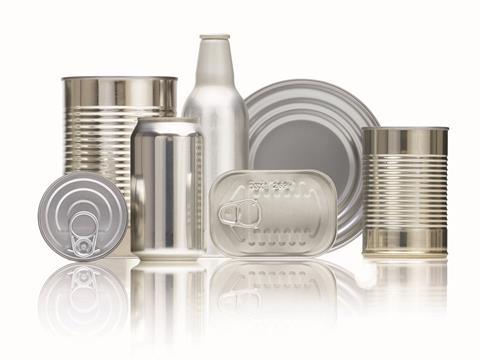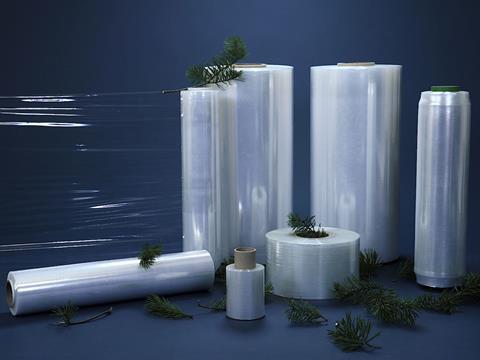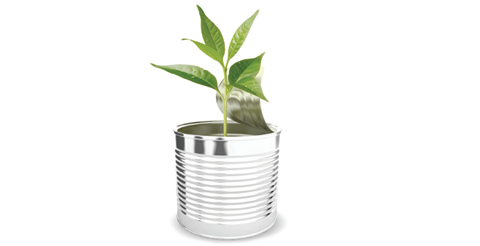
According to the recent Transparency market research ‘packaging coatings market’ report, the increasing need for maintaining original quality and taste and keeping a check on contamination are driving use of packaging coatings, especially in the food and beverages market. Growth opportunity for players operating in the global packaging coatings market lies in the usage of sustainable materials. Meanwhile, the direction of innovation has been driven by global concern about the side effects of chemicals (particularly BPA) and an increased emphasis on the aesthetic and haptic properties of packaging. Libby White spoke with the industry’s authorities about the state of the global packaging coatings market and the keys to forward-thinking R&D.
The international coatings community gathered in April at The European Coatings Show, held in Nuremberg, the largest show to date. Its organisers highlight sustainability and functionality as the main talking points driving the industry. On show were products for manufacturing water-based paints and low-VOC formulations, bio-based materials and sustainable raw materials. Solutions for antimicrobial coatings and technologies for manufacturing functional products were also in demand.
From the exhibition floor, the coatings industry considers itself well prepared for the future, as a survey by a market research institute showed: two-thirds of the exhibitors rated the prospects for the industry as positive. About 20 per cent expect developments to remain constant, with only three percent expecting any weakening.
Acclaimed international experts brought the audience of the European Coatings Show conference up to date on scientific and research developments in a total of 24 sessions, including two on sustainable products in the form of waterborne coatings and bio-based coatings. For example, Renaud Nicolaÿ from the ESPCI (École Supérieure de Physiques et de Chimie Industrielles de la Ville de Paris) showed how highly resistant vitrimers with novel properties can be generated: they are ductile, self-repairing and recyclable, and do not lose their properties when recycled.
The European Coatings Show Award for the best conference submission went to Bas Tuijtelaars of DSM Coating Resins. His award was for research into the production of amine-free resins. In his paper, he illustrated the development of a water-based polyurethane dispersion to replace triethylamine as a neutralising agent. The jury was won over by the potential of achieving a balance between health protection requirements and efforts to achieve outstanding performance.
Aesthetic and haptic appeal
When it comes to the decision to purchase, the way a product looks is important. However, whether the packaging is pleasant to touch is also increasingly becoming a decisive factor. Besides this, consumers are attracted by products that are packaged in a way that promises sustainability or suggests a return to traditional materials. An impressive example in this field is from Schur with its recent development Papertouch, plastic films characterised by a special coating such that they feel like paper to the touch.
Waxed paper packaging solutions add a trendy homemade look to sweets and feel surprisingly soft and pleasant to touch. The Schur Flexibles Waxed Paper solutions are based on a technology that uses natural, untreated wax to coat the paper, which is more biodegradable than paraffin-based solutions, for example. The base waxes can also be modified with polymers and additives to increase the shine of the paper's surface and to optimise its sealability. The material's special wood fibre composites and various surface sealants make it possible to refine the papers further. Sweet packaging made from Schur Flexibles wax-coated materials is easy to open and reseal and can also be printed on with up to eight colours without any difficulties.
The paper surface is particularly hard-wearing and does not scratch. Flawlessly packaged candy drops & co. are a highlight on the sweet shelves. For example, the Schur Flexibles Waxed paper range is perfect for packaging sticky sweets as the waxed paper makes them easy to take out of the pack.

Paper Look packaging – meaning packaging films that feel and also look like paper – are a real trend in the industry. Consumers are attracted by products with packaging that looks like ‘real paper’.
Schur Flexibles’ Paper Look range includes two- or three-layered paper laminates. Various very different materials are combined by means of a solvent-free technique. This makes it possible to manufacture customised packaging that looks and feels like paper for a specific product.
At the same time, it fully meets all of the requirements with regard to barrier, gloss, durability and sealing properties and therefore protects the product perfectly. The Paper Look solutions are easy to process and can be HD flexo-printed with up to ten colours – which creates a really eye-catching display at retail.
Breaking with tradition
The light metal packaging industry is moving away from traditional BPA-based coatings due to regulatory demands, and consumer and NGO preferences. Flavio Marchi, global marketing director, Valspar Packaging explains that the company has been doing a great deal of innovative product development to address these concerns.
He comments, “Valspar has the broadest portfolio of coating solutions, including non-BPA offerings, providing the can makers and brand owners with choices. Our newest innovation, using our Safety by Design development protocol based on the pharmaceutical model, is the valPure® V70 series of coatings for food and beverage containers. valPure V70 was recently awarded the Bronze METPACK 2017 Innovation award during the show in Essen, Germany.”
valPure® V70 is a next-generation non-BPA coating that gives can makers and brands the performance and protection they have come to expect from traditional epoxy-based coatings. V70 was designed to achieve the strongest performance while meeting the highest safety standards – even beyond those required by regulatory agencies, as supported by leading academic toxicologists and validated by the toughest critics, including NGOs. Researchers at leading universities including Tufts, Baylor, and Colorado State University studied this molecule and results are now being published.
“With the strides we’re making in non-BPA innovation, it’s an exciting time to be in the metal packaging coatings industry,” Mr Marchi enthuses. “We’re pushing the boundaries of technology, expanding our product line and gaining the trust of key industry stakeholders to further strengthen our position as the leader in next-generation non-BPA coatings.”
V70 for two-piece beverage can and end applications offers drop-in solutions for epoxy-like performance while maintaining current line efficiencies on the same equipment. V70 for food can applications offers epoxy-like performance in solvent- or water-based formulations for exteriors on sheet or coil and for D&I can interiors. Major customers and brand owners are converting to valPure V70 products to meet their non-BPA conversion requirements.
Valspar is very proud of this innovation in non-BPA technology and pleased by its market acceptance and expansion into the industry. “We will continue developing, reviewing, and refining new technologies to meet the needs of our customers today and in the future,” adds Mr Marchi.
Driving a revolution
Next generation, award-winning technology from Dow Coating Materials could drive a revolution in can coatings, by facilitating health-conscious food and drink producers to turn away from epoxy coatings using bisphenol A (BPA) and other materials of concern.

Whilst cans offer great consumer convenience, coatings are needed to protect containers from corrosion, and the contents from contact with metal, helping preservation, flavour quality and consumer safety.
Yet with traditional epoxy coatings using BPA – a material that has raised health concerns – alternatives are in demand from progressive brand owners wanting to address evolving consumer demands.
Now, technological developments at Dow have facilitated a tried and tested option for flexible and rigid plastic food packaging to be applied to can coatings too: thermoplastic polyolefins, with a specially designed mix of functionalised and non-functionalised polyethylene or polypropylene in an aqueous dispersion.
Without materials such as styrene, epoxides and phenolic crosslinkers, breakthrough CANVERA™ Polyolefin Dispersions from Dow offer a water-borne, spray-applied replacement for epoxy coating systems, eliminating BPA use and delivering brand owners a new approach to safe, sustainable can coating that will appeal to health-conscious consumers.
Powered by patented BLUEWAVE™ Technology, which facilitates creation of ultra-thin, thermoplastic film coatings, CANVERA™ Polyolefin Dispersions can be spray-applied from water-borne formulations to the inside of cans, protecting contents from changes in colour, taste or appearance.
With cost effectiveness and seamless manufacturing productivity high on the agenda, producers also benefit from drop-in performance: the technology can be used on existing lines and applied directly to metal surfaces by the same equipment used for current epoxy coatings.
Dow’s CANVERA™ Polyolefin Dispersions for metal can coating received a bronze 2017 Edison award. “Dow Coating Materials has been working on this progressive technology for several years, and it is really exciting to finally see it being adopted by the market place,” remarks Neil Carr, business president, Dow Coating Materials, Performance Monomers and Plastic Additives. “CANVERA™ Polyolefin Dispersions offer a genuine breakthrough in can coatings, and are a great testimony of our business’s ability to deliver science-based, sustainable solutions that aim to improve people’s lives.”
Eliminating concern
AkzoNobel strengthens its position in the food coatings segment by introducing Vitalure™ G2 10 – a new generation of polyester coatings for the internal protection of three-piece food cans and ends.
The new internal coating for three-piece food cans from AkzoNobel combines key features—excellent barrier performance, strong sulphur resistance, and sustainability—delivering a global platform which meets regional requirements across all geographical areas.
“Our objective was to develop a solution with barrier performance better than Epoxy technologies while eliminating materials of concern, including of course BPA,” says Luc Viardot, global segment manager, Food, at AkzoNobel Metal Coatings.
“We aimed to provide our customers with a stronger platform in terms of chemical resistance for many types of food via a solution which can be used in multiple regions across the globe. This technology already has a proven track record in terms of application and chemical resistance in different regions. The metal can industry has faced many challenges over the last few years. However, challenges stimulate AkzoNobel to bring our customers the right answer in a timely manner. Our customer requirements are very different across the food metal can business and we strive to bring global solutions which can be adapted to meet regional and local needs. The product is designed to be applied in a 1- or 2-coat system depending on the properties of the food which is to be contained. The coating can be applied at low film weight and has excellent powder side stripe adhesion. We developed this platform together with our customers; we value their input at each stage of the project and we see the results now!”

“We are anticipating future legislation and aim to lead the market in terms of sustainability,” adds Dominique Fort, marketing director, AkzoNobel Metal Coatings. “We believe that not only our customers but also consumers will benefit from new technologies which will drive the market toward more sustainable solutions. With our 40 years of experience in the metal packaging business, billions of food and beverage cans coated with our products and a wide coating portfolio in many different segments, we are best positioned to provide our customers with solutions which meet the needs of today and tomorrow.”
It is apparent that coatings are bringing advanced solutions to both the inside and outside of packaging. On the one hand, the coatings market is driving forward sustainable and safer materials for inner protective layers, and there is also a trend in the market towards using coatings on the outer surface of packaging to boost shelf appeal and attract consumers.
Coatings address an abundance of concerns in the market and held by consumers today: health, sustainability, environmental, shelf appeal, corrosion resistance, and protection, ultimately leading to innovation and the development of forward-thinking materials for tomorrow’s generation.










